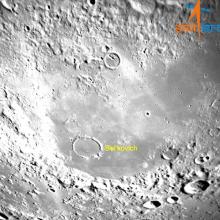Listen to today's episode of StarDate on the web the same day it airs in high-quality streaming audio without any extra ads or announcements. Choose a $8 one-month pass, or listen every day for a year for just $30.
You are here
Moon and Companions
A couple of bright companions attend the Moon this evening. Aldebaran, the orange eye of Taurus, the bull, stands just to the left of the Moon. And Venus, the brilliant “evening star,” is well above them.
The Moon is a thin crescent right now. That means it’s nighttime for most of the hemisphere that faces our way. It’s daytime only for the bright crescent.
That doesn’t mean it’s fully dark on the lunar nightside, though. In fact, it’s pretty bright. You can see that for yourself as the sky begins to darken. Most of the lunar disk will take on a ghostly appearance – the result of earthshine – the brilliant glow of our home planet.
If you were standing on the Moon, you’d see an almost-full Earth hanging in the sky. Earth is almost four times wider than the Moon, so it’s a much bigger target in the lunar sky than the Moon is in ours. And, on average, Earth reflects about three times more sunlight than the Moon does. The exact number varies depending on cloud cover and which part of Earth you’re looking at. So a full Earth is about 40 times brighter than a full Moon.
And except from the edges of the Moon’s disk, Earth never rises or sets in the lunar sky. That’s because the same side of the Moon always faces our way. So from any point on that hemisphere, Earth always hangs in the same spot. Our planet waxes and wanes but doesn’t move – a constant presence in the lunar sky.
We’ll have more about the Moon and Venus tomorrow.
Script by Damond Benningfield





